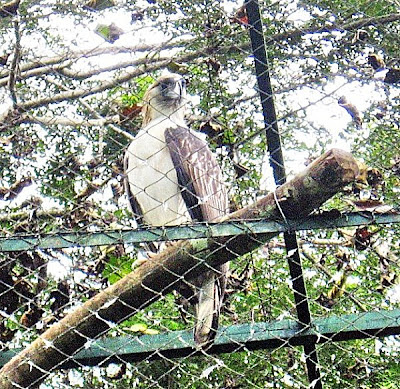 |
| Pag-Asa, the first eagle to be bred |
After lunch at Jay Mendoza’s residence, he drove me all the way to the Philippine Eagle Sanctuary and Wildlife Preserve, a natural captive breeding facility established to conserve the critically endangered and mighty Philippine eagle (Pithecophaga jefferyi), the country’s national bird.
Locally called haribon (short for “hari ng ibon” or “king of birds”), it is also the symbol and icon of Davao City. Its 2-m. (6.5 ft.) wingspan also makes it the world’s second largest eagle after the Central and South American harpy. Due to illegal logging and irresponsible cutting of trees (resulting in a loss of habitat), its uniqueness (there is a demand for it in major zoos of the world) and its very size and majestic stance (making it a very desirable target as a trophy), the Philippine eagle has become critically endangered.
 |
| Jay Mendoza |
In 1987, the private, non-profit Philippine Eagle Foundation, Inc. was organized to save the eagle through captive breeding management, field research, community-based enterprise development and conservation education. They set up the Philippine Eagle Sanctuary and Wildlife Preserve near Calinan, 36 kms. northwest of the city. This nature park, spread over a large forest preserve, is planted with different fruit-bearing trees and is now home to 14 of these Philippine eagles, out of a known population of 119 (2 others in the DENR office in Los Baños, Laguna, 96 in Mindanao, 5 in Aurora and the Sierra Madre Mountains and 2 in Samar).
 |
| Philippine Eagle Sanctuary |
The Philippine Eagle was first recorded by John Whitehead on a collecting expedition in 1896. Formerly called the monkey-eating eagle (now amended), it is called manaol by the Cebuanos and Muslims, aguila by the Tagalogs and mamboobook or malamboogook by the Bagobos, Mandayas and Tagakaolos. It is only found in the Sierra Madre mountains in Eastern Luzon and the heavily forested area of Mindanao.
This eagle stands one meter high, weighs an average of four to seven kilograms, and has a powerful bill, strong legs and claws and eyesight eight times that of a human. Its general body color is grayish brown on the back and wings, white at the front neck and belly and has shafts of gray brown streaked feathers on the head which, when erect, forms a crest. Its raw meat menu includes flying lemurs (kaguang), wild cats (musang), flying squirrels (tapilak), snakes, chickens, bats and monkeys.
 |
| Brahminy Kite |
Flying at speeds of 70 to 80 kms. per hour, one eagle claims and defends a wide, 60 to 100-sq. km. territory in lowland and medium elevation forest and nests (a crude platform shaped by branches and twigs) are established approximately 80 ft. atop the tallest trees in the jungle (sufficient enough for it to have a good view over its territory) or on high promontories overlooking a stream or river.
The Philippine Eagle is a faithful mate, having been observed to usually prefer a monogamous lifestyle. At breeding time (between August and January), they usually indulge in high-soaring aerial courtship and are said to mate in mid-air, in or near the nest. The female lays one white egg every two years and both parents alternately incubate the egg for about 60 days until it hatches. Usually the male does the hunting, sharing his catch with the female and the young, especially during breeding time. Hunting flights extend to the cleared areas as well. The eaglet fledges within 150 days and becomes independent at 18 months, at which time the parents drive the juvenile out of their territory. It matures after 6 years.
 |
| Philippine Brown Deer |
On January 15, 1992, Pag-asa (“hope”) was born in the center, the first eagle to be bred in captivity. A second eaglet, born five years later, was named Pagkakaisa (“unity”). On February 23, 1999, another eaglet, Pangarap (“dream”) was born through artificial insemination, followed by Maginoo (“respectful”) on December 15, 2000.
The center is also home to other indigenous birds such as Brahminy kites (Haliastur Indus), African grass owls (Tyto capensis), crested serpent eagles (Spilornis cheela), Philippine hawk-eagles (Spizaetus philippensis), grey-headed fish eagles (Haliaeetus ichthyaetus), white-bellied sea eagles (Haliaectus leucogaster) and cockatoos; and wildlife such as tarsiers (Tarsius philippensis), Philippine deer (Cervus mariannus), saltwater crocodiles (Crocodylus porosus), crab-eating macaque(Macaca fascicularis) and reticulated pythons (Python reticulatus).
 |
| Sunbathing macaques |
